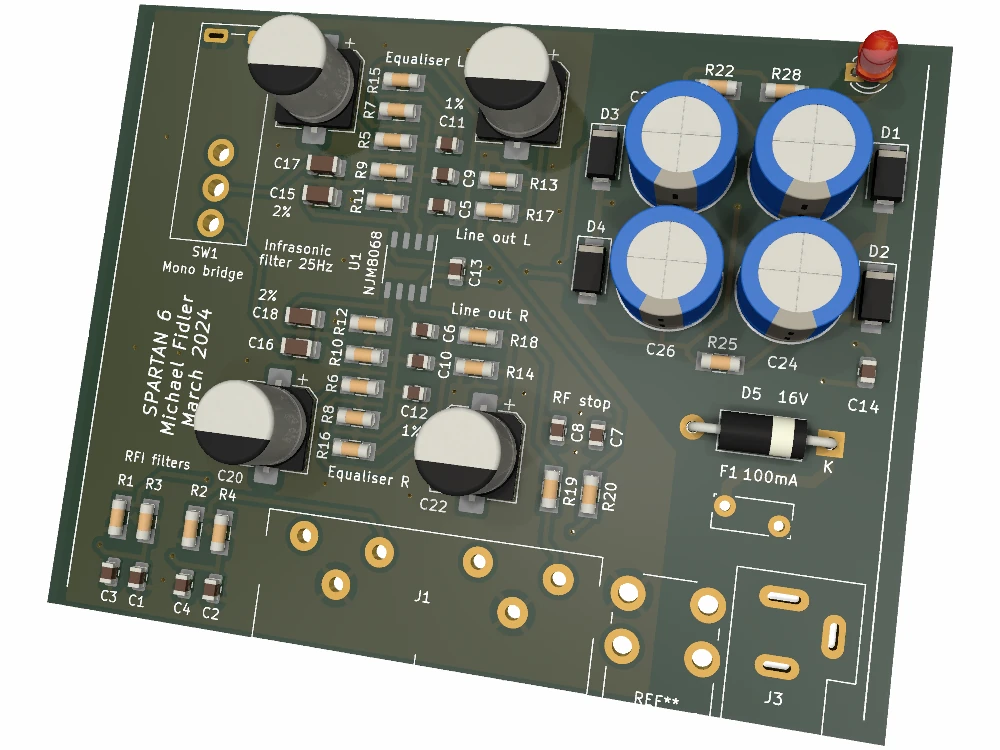

The new SPARTAN 15 phonostage could be the best thing on the market for MM performance on a budget! Marc Henshall had a listen to this complete rethink of the discontinued SPARTAN 10 design that made waves in the UK back in 2022.
Sound Matters video review
The first thing that struck me about the Spartan 15 was just how quiet it is when idle; clearly, Michael’s two-stage amplification design and choice of components are paying off from the very start. On firing up a number of very familiar records, I was equally impressed with the playback performance. Transients are sharp, fast, and incredibly clean, bringing a sense of confidence to the overall presentation. The clarity in the low-mids, in particular, is exemplary, allowing me to hear more precise and clean bass notes compared to much of the competition.

Marc Henshall, Sound Matters

Silver SPARTAN 15
With a 13% price drop compared to its predecessor, the SPARTAN 15 offers even better value for money than ever before, for a true taste of UK-made high end in a compact form factor without the high-end price tag. Now available to ship worldwide!
In addition to silver finishes, the top of the range MM and MC PRO phonostages now have a new enclosure style to match the pitch black low-noise backgrounds they bring to music, thanks to their class-leading input amplifier designs.

Black MM PRO
Continuously variable noise cancelling low frequency crossfeed, a precision ±0.1dB RIAA dedicated equalisation amplifier stage, 3rd order subsonic filter, gain switch for low output cartridges, and a fully balanced output that can drive 20V RMS into a 2kΩ load, make for what may very well be the best vinyl listening currently on the market.

Balanced line outputs
So what does it sound like? Clean, accurate, and as good as the rest of your system. You can’t characterise the sound of the MM pro because it doesn’t have a ‘sound’. It is ruler flat from subsonic into ultrasonic frequencies (besides the intentional subsonic filter), is impossible to overload with any magnetic cartridge or record, has more than enough output to drive any line stage into clipping with a sufficient input signal, is so quiet as to be inaudible beneath the quietest pressing, and has almost immeasurable distortion.
Ashley Cox, Audio Appraisal
When Audio Appraisal reviewed the MC PRO in March 2023, Ashley was unable to find a better performing product on the market and kept it for his own system. Half a year later, he also tried the MM version and came to the same conclusion as before! Are you ready to find out what your setup can do with no bottleneck at the first critical stage?
When the PRO series were first released, many people didn't believe that the published measurements were real, or even possible; not surprising in a market saturated with magical claims and snake-oil products. To prove this wasn't just more of the same, an MC PRO phonostage was submitted to Audio Science Review for independent measurements.

MC PRO on Audio Science Review
True to its advertised performance, the MC PRO then went on to gain the coveted 'Golfing Panther' award for the highest-ranked category of products.
YouTube summary of the MC PRO tests
What is extremely nice is flatness of the equalisation. The variation is just stunningly small, so very nicely done. This is one of the most important things where tonality is concerned.
I sweep it at different frequencies and basically it doesn't care which is very very nice and unusual. If I throw out noise and measure distortion you see distortion levels are extremely good, we're talking digital audio levels of distortion.
So bottom line: this is just a fantastic phonostage. It looks good, it's got good innovation in the feature set and I highly, highly recommend it.
Amir Majidimehr, Audio Science Review
All too often, cheap switching power supplies are commonplace in consumer audio, leading to ill effects ranging from audible mains buzz, all the way to damage to the equipment unfortunate enough to be connected up to these cheap and noisy devices. To suppress the switching noise to the legally required levels, the output has to be coupled back onto the mains with a small capacitor, injecting mains currents into the audio ground path.
To make things worse, these cheap units mostly use a sub-optimal 'single supply rail' arrangement, where the audio reference ground is injected with the highly non-linear power currents of active amplifying devices which often significantly degrade distortion performance. Sometimes an internal DC to DC converter is used to generate a split supply, but that brings the screeching switching electronics into the enclosure right alongside the sensitive linear audio path.

Linear transformer PSUs
Bucking the current cost-driven trend, Classic Audio Ltd believes in investing in high quality parts to avoid trouble straight out of the gate. Instead of having a switching supply that injects noise, and makes a prerequisite for a compromised design, Classic Audio uses an old-fashioned low frequency transformer based design, that takes the transformer and its troublesome magnetic field out of the enclosure and down to the wall socket.

Symmetrical linear rail generator
To ensure the customer gets excellent sound straight away, no products are advertised with optional premium 'upgraded' (read adequate!) parts. All Classic Audio components are optimised as standard, with literally 100 times less capacitative coupling to the mains than other manufactures who offer linear upgrades that only partially improve a design intrinsically compromised for use with switching adapters. That standard means that Classic Audio power supplies are low frequency, linear, split supplies that keep the power currents out of the ground path, just like the one pictured above; a power supply you can truly rely on not to get in the way of the music!
Want the low down on new products, projects in development, and general regular updates?

SPARTAN 6 phonostage using surface-mount technology
Follow the Michael Fidler - Classic Audio Ltd. Facebook page for early information.